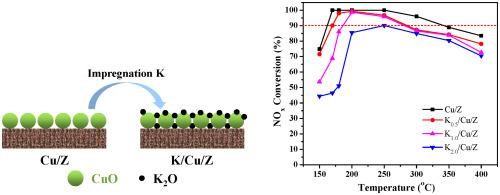Colloid and Interface Science Communications ( IF 4.5 ) Pub Date : 2021-07-24 , DOI: 10.1016/j.colcom.2021.100465 Hongyan Xue , Xiaoming Guo , Tao Meng , Dongsen Mao , Zhen Ma

|
Cu/ZSM-5 is able to catalyze the reduction of NOx to N2 (NH3-SCR), but the poisoning effect of K in this regard has been barely studied. Herein, the poisoning effect of K with respect to Cu/ZSM-5 in NH3-SCR was established via catalytic testing, and both Cu/ZSM-5 and K-poisoned Cu/ZSM-5 were probed by using XRD, N2 sorption, TEM, H2-TPR, XPS, NH3-TPD, and NO-TPD. In addition to these characterization tools, in-situ DRIFTS was employed to probe the adsorbed species and reaction intermediates, thus giving important information about the possible reaction mechanisms. In all, the presence of K led to decreased exposure of active CuO dispersed on ZSM-5, inhibited the adsorption of NH3 and NOx to some extent, minimized the formation of active bridged nitrate, and facilitated the formation of inactive bidentate nitrate.
中文翻译:

K 对用于 NO 还原的 Cu/ZSM-5 的中毒效应
Cu/ZSM-5 能够催化 NO x还原为 N 2 (NH 3 -SCR),但 K 在这方面的中毒效应几乎没有研究。在此,K对NH 3 -SCR中Cu/ZSM-5的毒化作用是通过催化测试建立的,并通过XRD、N 2探测Cu/ZSM-5和K中毒的Cu/ZSM-5吸附、TEM、H 2 -TPR、XPS、NH 3 -TPD 和 NO-TPD。除了这些表征工具,原位DRIFTS 被用来探测吸附的物质和反应中间体,从而提供关于可能的反应机制的重要信息。总之,K的存在导致分散在ZSM-5上的活性CuO的暴露减少,在一定程度上抑制了NH 3和NO x的吸附,最大限度地减少了活性桥接硝酸盐的形成,并促进了非活性二齿硝酸盐的形成。



























 京公网安备 11010802027423号
京公网安备 11010802027423号